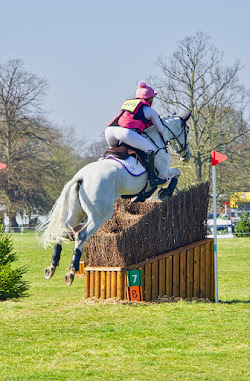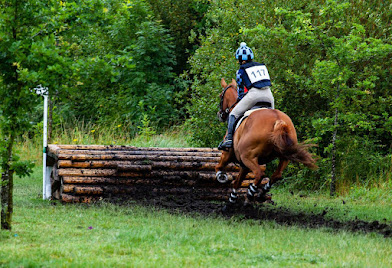And How to Judge if it’s Done Well
By the time you read this, I will be standing out in the middle of a field somewhere, probably in the rain. (It is, after all, almost July in the UK.)
The reason for actually taking a day away from my computer keyboard may sound like a strange one, although they reckon people do things as a hobby that you could not possibly pay them enough to do as a job.
I shall be attending the Dubarry British Eventing Horse Trials, being held at Eland Lodge at Draycott-in-the-Clay, near Ashbourne in Derbyshire. Not competing, I hasten to add, nor as a spectator. Instead, I’ll be fence judging on the cross-country phase of the event.
Well, I did say it might sound like a slightly strange way to spend a Sunday, but each to their own.
It’s a very long time since I actually took part in any kind of equestrian event, but I still enjoy watching the combination of bravery and skill demanded by eventing at any level. And it’s very satisfying to know I’m one of the large number of small cogs that help the day run smoothly.
It’s a nice theory, anyway.
Safety First
The main reason you have fence judges for a cross-country event is for safety. We are there to ensure the course is clear of spectators when the next rider approaches our obstacle, and to be immediately on hand if anything goes awry.
The last time I was doing this, I managed to catch two loose horses who’d dumped their riders. One had been attempting the fence before, and one the fence after. We also ended up summoning the paramedics—always on stand-by at competitions like this—for a fallen
 |
| OK, this is a loose racehorse rather than an eventer, but you get the idea... |
 |
| Most riders now choose to wear protective body air jacket while out on their horses, regardless of activity. |
Direction and speed
The fence judges are also there, of course, to make sure that each competitor attempts the correct fence, takes the correct route if the obstacle has several parts, and doesn’t incur any penalties.
Because
Jumping the wrong fence, and not going back to correct the mistake by jumping the right one, results in elimination from the event.
 |
| The indicate the route for different classes on the day. |
To stop people galloping madly at big cross-country fences in an attempt to finish the course fastest, there is an optimum time. Most riders will try to get as close to this as possible. Going too fast will not only exhaust the horse, but for every second in excess of 15 seconds under the optimum time, the rider scores 0.4 penalties. The same penalties per second are scored for every second over the optimum time.
 |
| There is an optimum time for every event, so going too fast can result in as many penalties as going too slow. |
Refusals
By its nature, a cross-country course is a test of horse and rider. Often fences will be very
A second stop at the same obstacle scores 40 penalties. Three

An example of a narrow fence. The horse must
jump between the flags.
In the smaller and more novice classes, there can be a bit of dithering before a fence. This often happens where the landing side is much lower than the take-off side, or when jumping into
 |
| There can be a bit of dithering before an inexperienced horse jumps into |
Providing the horse doesn’t take a step back with any foot, and the rider doesn’t circle away, even jumping from a standstill may still result in a clear. It’s not to be recommended, though, and it will make it very difficult to meet that optimum time, which relies on a reasonable forward pace.
Of course, if we have the typical British weather—ie, downpour—it can make the ground fairly treacherous. Fortunately, many of Eland’s fences have all-weather take-off and landing areas, so even if it chucks it down, that’s one less thing to worry about.
 |
| I confess I would not like to be jumping in these conditions. Studs in the horse's shoes to provide extra grip are a must. |
At one time, cross-country fences were fixed
 |
| The devices which allow the top rail to drop down may prevent a fall, although penalties are awarded if any are triggered. |
So, think of me today, with
For their part, Eland provides all their event volunteers with breakfast, a packed lunch, and supper at the end of the day, as well as flasks of tea and coffee, and—if it’s a fine day—even the occasional ice cream.
How have you been spending your Sunday?
This week’s Word of the Week is
Events
I was delighted to be interviewed this week by fellow crime author Dawn Brookes for her podcast series The All Things Books Show. Catch it on YouTube: https://youtu.be/NFxEm4KHGaY.















Do you get bonus points or penalty points if attacked by a swarm of Caro Midges? Also, I believe nudiustertian is also the name of a flower (related to orchids) that looks remarkably like a naked human. I may be wrong on that one.
ReplyDeleteFortunately, the competitors are usually travelling too fast to be attacked by Caro midges. Yesterday, considering the long grass alongside the course was thigh-high, I was more worried about adders!
DeleteYou need a manual to keep track of all the things you've got to do. Personally I have a very bad history with horses - they always win.
ReplyDeleteMy father also subscribes to the Ian Fleming theory on horses: dangerous at both ends and uncomfortable in the middle.
DeleteHobbyhorses with soft saddles are the extent of my experience with any rides upon the grand stallions and mares of fence jumping.
ReplyDelete